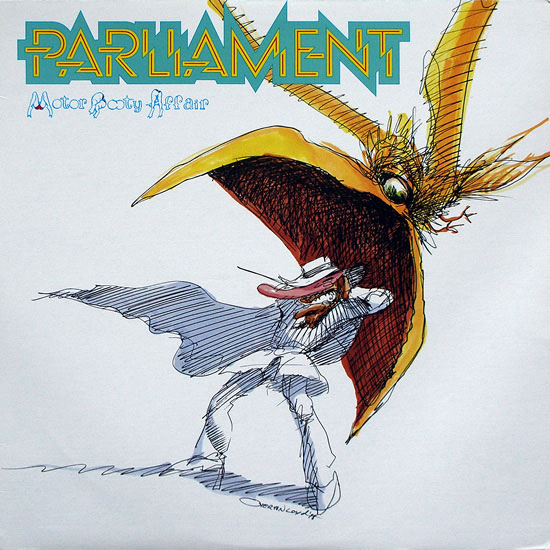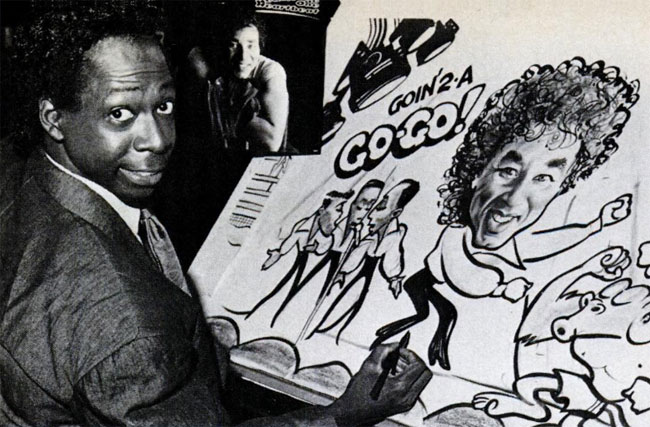'Doctor Funkenstein VS Sir Nosedevoidoffunk' from Parliament's 'Funkentelechy vs. the Placebo Syndrome' (1977) sleeve.
Overton Loyd is an American caricaturist, comic artist, animator and illustrator, best known through his association with funk legend George Clinton. He created the comic book inside the sleeve of Parliament's album 'Funkentelechy vs. the Placebo Syndrome' (1977) and illustrated the covers of the band's subsequent three albums. Together with Pedro Bell, Ronald P. Edwards and Diem Jones, he contributed to Clinton's P-funk philosophy and wacky public image. And together with these artists and people like Cal Schenkel (Frank Zappa), Hipgnosis (Pink Floyd) and Lemi Ghariokwu (Fela Kuti) Bell was one of the best known album cover artists who gave one specific musician or band a visual identity. He refers to his style as "funk aesthetic" and/or "bop art." His fine art paintings go by the moniker "urban expressionism". The artist is convinced that art can ignite a breakthrough in communication, allowing people to shift their consciousness, embrace their humanity and access the eternal, which he summarizes in the slogan: "Transform the Norm".
Early life and career
Overton Loyd was born in 1954 in Detroit, Michigan. Among his graphic influences are Salvador Dalí, Henri de Toulouse-Lautrec and Edgar Degas. He started his career making caricatures at state fairs and illustrations for magazines. In 1971, at age 17, Loyd was once sketching at a café, where a woman from Isaac Hayes' entourage invited him to the soul musician's birthday party. It was for this event that Loyd decided to create an oil painting of the famous 'Theme From Shaft' singer. As the in-house artist for the Shelby Hotel in Detroit, Loyd painted a mural for the club JJ's Lounge, where he met people like jazz musician Sun Ra and comedian Martin Mull. Mull motivated him to move to New York City in 1976, where his wife Kristen Johnson worked as an illustrator. She introduced Loyd to Robert Grossman (the poster artist of the film 'Airplane!', 1980) who took him as an assistant.
Album cover illustration for 'Motor Booty Affair' (1978).
George Clinton
Through a colleague at Shelby Hotel, Joey Zalabak, Loyd got in touch with George Clinton, the eccentric brain behind the legendary bands Parliament and Funkadelic. Funkadelic was known for their psychedelic rock sound with funky grooves parodying that very same genre. Parliament combined outer space-themes with catchy dance music. Both bands promoted peace, free love and black consciousness, but with a sense of humor. Clinton's shows were full of funny lyrics, wacky wigs and costumes, complete with giant UFOs landing on stage. The lunacy never got in the way of breathtaking musicianship, performed, among others, by guitarists Bootsy Collins and Eddie Hazel, which sometimes went on for three hours in a never-ending party. At that point Clinton already had a house illustrator, Pedro Bell, but Loyd was just as welcome. Bell and Loyd are often confused with each other and it's not hard to see why. Both were the most productive illustrators George Clinton ever worked with, helping out designing album covers, concert posters and other associated merchandising. The main difference is that Bell's style was more crude, while Loyd was professionally skilled. Also, Bell was mostly preoccupied with artwork for Funkadelic, while Loyd was the main illustrator behind Parliament's records.
One day Loyd hung out with Parliament in a hotel room when somebody handed out clown noses for the next stage show. He sketched Clinton with one of these noses, which gave him the idea of a Cyrano de Bergerac-like character. Clinton suggested dressing this character like a stereotypical black pimp and named him Sir Noze D'Voidoffunk. On the concept album 'Funkentelechy vs. the Placebo Syndrome' (1977) the evil Sir Noze tries to fight funk music, personified by the heroic characters Dr. Funkenstein and Starchild. But in the end even he can't resist the groove. Loyd turned this story into an 8-page comic book, printed inside the album's sleeve. The sleeve also featured a poster by Loyd depicting Sir Noze.
Comic strip for the inner sleeve of 'Gloryhallastoopid (Or Pin the Tale on the Funky)' (1979).
Bell designed the covers for Parliament's next three albums: 'Motor Booty Affair' (1978), 'Gloryhallastoopid (Or Pin the Tale on the Funky)' (1979) and 'Trombipulation' (1980). Apart from the cover of 'Motorbooty Affair', Loyd created cardboard cutout figures and illustrations of the characters who played a role in the lyrics, including 'Mr. Wiggles' and 'Rumofsteelskin'. He also sang backing vocals on the record and designed costumes for the accompanying tour. To top it all off, Loyd also created a TV commercial to promote 'Motorbooty Affair' , which was his first experience with animation. Inside the sleeve of 'GloryHallaStoopid' (1979) was a comic strip inspired by the album's concept, presented in the shape of a flower bud. Each bud features a comic strip panel, which one could read in clockwise fashion.
Over the decades Loyd remained involved with Clinton's entourage, designing costumes, stage shows and album covers for his various musical endeavors. By the 1980s Parliament and Funkadelic were disbanded, and Clinton embarked on a solo career. In 1982 he released the hit single 'Atomic Dog'. The computer animation in the music video by Peter Conn was created by Loyd. Although the single was recorded in 1982 it still took until 17 February 1984 until the video aired on MTV, because at the time the network only gave rock and pop music airplay, excluding all other genres. Thanks to Michael Jackson's monster success in 1983, MTV had to abandon this policy, giving musicians like Clinton airplay. The video won Billboard's "Best Use of Computer Graphics" award. Loyd also designed the front and back cover of 'T.A.P.O.A.F.OM.' (1996) by George Clinton & The P-Funk Allstars, which also came with a tiny comic strip titled 'Bonus Back Cover Follies!'. The same year he also designed the front of the album 'Greatest Funkin' Hits' (1996), which - despite the title - isn't a compilation, but instead a remix album. Loyd also livened up the cover of the single 'Get Yo Ass In The Water And Swim Like Me' (1997), 'How Late Do U Have 2BB4UR Absent?' (2005), the genuine compilation record 'The Best of Parliament: Give Up The Funk' (1995) and the Funkadelic album 'First Ya Gotta Shake The Gate' (2014).
Loyd designed the book cover of 'Brothas Be, Yo Like George Ain't That Funkin' Hard on You?' (Simon & Schuster, 2014). For Clinton's protegé Bootsy Collins he created the cover for his fourth album, 'This Boot Is Made For Fonk-N' (1979), with Bootsy's Rubber Band. The record came with an 8-page comic book, 'The Almost Finished Coloring Comic', drawn by Loyd. In 1990 he illustrated their album 'Jungle Bass' (1990), complete with an animated music video to promote the song 'Disciples of Funk'.
Back cover with comic strip for George Clinton & The P-Funk Allstars' 'T.A.P.O.A.F.O.M.' album.
Other album illustration work
While Lloyd is closely associated with George Clinton, he also designed album or single covers for other musical acts, among them 'With Respect' (1990) and 'Waltz Of A Ghetto Fly' (2003) by Mr. Fiddler. He livened up the covers of 'Love Sign' (1973) by The Counts, 'Zapp' (1980) by Zapp, 'L.A. Connection' (1982) by L.A. Connection, 'Packet Man' (1990) by Digital Underground, 'Lil Trig' (1991) by Hen-Gree & Evil-E, 'Television, The Drug Of The Nation' (1991) by The Disposable Heroes of Hiphoprisy, 'Funkology' (1994) by Dazz Band, 'Jazzonia' (1998) by Bill Laswell's Jazzonia, 'Journey To Anywhere' (2000) by Ugly Duckling, 'Weapon of Choice' (2005) by Nutmeg Party and 'Fish Feet' (2009) by Ron English.
TV career
Loyd provided art direction to the music video 'Disrespect' (1984) by The Gap Band, on which Jerry Brice was the lead animator. Loyd was guest art director of the episode 'Home' (2006) in the animated TV series 'Class of 3000'. He also designed characters for the animated short 'Tallica Parking Lot' (2013) by Juno John Lee, which features the voices of Bootsy Collins, Trey Parker and Matt Stone (as Stan, Kyle, Kenny and Cartman from 'South Park'), Lemmy (Motörhead) and the entire line-up of Metallica. To conclude, Loyd was a regular face in the American TV game show 'Win, Lose or Draw' (1987-1990) too, where he often provided caricatures.
Episode of Jerry Brice's hip hop strip 'No Joke!' by Brice and Overton Loyd on the occasion of Malcolm X Day Black History Month in the early 1990s.
Graphic contributions
Loyd drew the back cover for Harlan Ellison's 'Dream Corridor Special' (Dark Horse Comics, 1995), for which science fiction novelist Ellison was the scriptwriter. He also made illustrations for Ray Bradbury's book 'Dinosaur Tales'. (1983) and Chris Pyronoski's 'Titmouse Mook Vol. 2' (2012). He was also one of the artists of Jerry Lee Brice's hip hop comic strip 'No Joke!' (1990-1994) which ran nationally in The Source magazine and locally in Southern California in Urb.
Graffiti art
Inspired by Keith Haring, Loyd started to paint citizens of the Homeless District in Los Angeles and posted these acrylic paintings all through the neighborhood. His intention was to transform the dilapidated district into a kind of secret pop-up gallery, though clear in sight. After noticing some people took them away, he added messages of empowerment for the collectors to carry with them. Over the years Loyd has also collaborated with Gustavo Alberto Garcia Vaca, ManOne and Jim Mahfood. Since the early 1990s his artwork has often been exhibited.
Legacy and influence
Overton Loyd, Pedro Bell, Ronald P. Ewards and Diem Jones provided George Clinton's music with a cartoonish visuality in a time when music videos were still rare and most advertising had to be done through tours, radio airplay and record sleeves. Their funky album covers were precursors of the cartoony album covers by some hip hop artists in the next decades. Loyd was a huge influence on comic artists and designers Gerone Spruill, Anya Davidson, Tim Fielder, Dawud Anyabwile and U.S. graffiti artist and muralist Stephen Powers, aka ESPO who once said: "Overton Loyd is as important to me as Henri Matisse."
Overton Loyd draws Smokey Robinson (Jet magazine, 26 September 1988).








